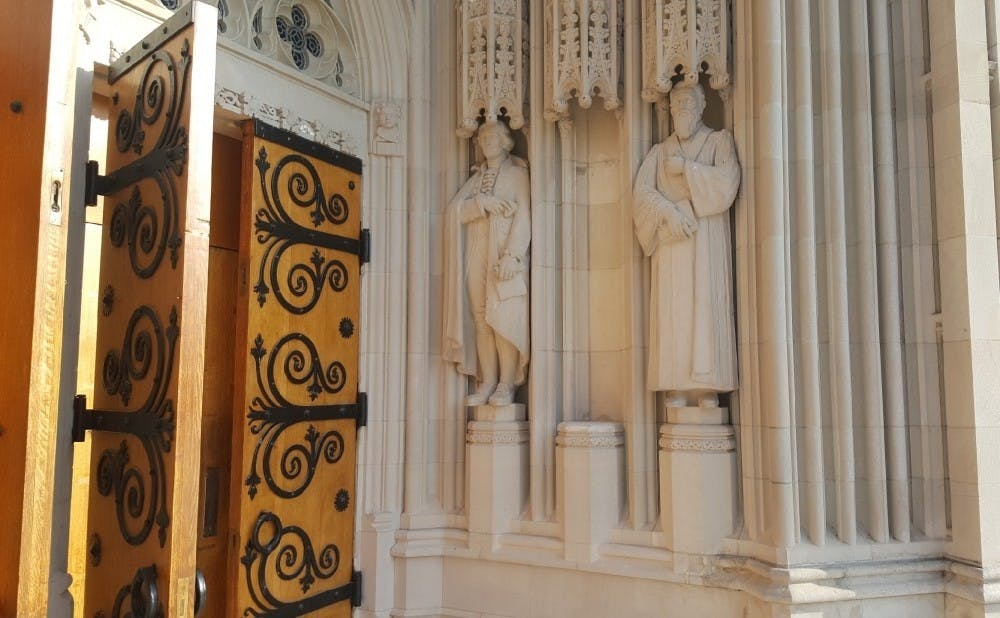The empty space that resulted from the removal of the Robert E. Lee statue will officially remain an empty space, at least for now.
In an announcement to the Duke community Saturday, President Vincent Price publicized a report completed by the Commission on Memory and History. In September, Price announced the creation of the commission, which was charged to propose principles to address issues regarding on-campus memorials or facility names.
The commission delivered its report to Price by Nov. 17, the set deadline, but it was not made public until Price made a recommendation to the Board of Trustees during its meeting Saturday.
“I am accepting the Commission’s first recommendation of leaving the space vacant and initiating an open and deliberative process that will involve all members of the Duke community,” Price wrote in his announcement.
Until August, a statue of former Confederate Gen. Robert E. Lee stood in front of Duke Chapel, but widespread controversy in the wake of violence involving white nationalists in Charlottesville, Va. prompted hundreds of alumni to sign a petition calling for the Lee statue to be removed. The statue was vandalized Aug. 17, and days later Price ordered the removal of the statue from campus. Two weeks later, Price established the commission.
Price issued three charges in creating the 16-member commission. Members were asked to propose principles to guide Price and the trustees in the event of controversy about a memorial or the naming of a campus facility. Furthermore, the commission was charged to provide input to Price and the trustees in developing procedures in future situations.
Two options were provided by the commission for the vacant Robert E. Lee space. The primary recommendation—“preferring to leave the space open for a year before taking further action”—was supplemented with the possibility of installing a plaque describing the history and significance of the empty space.
“This space would be a visual pause as the University dedicates itself to exploration and learning about our history,” the report stated.
The second option for the vacant niche was to name a person to fill the space. With "substantial support" from the commission and Duke community, the report proposed Rev. Dr. Martin Luther King, Jr. and Rev. Dr. Pauli Murray. Commission members decided that if the empty space was to be filled with a new individual, it should address the lack of commemoration for women and people of color in Duke Chapel.
“Both Dr. King and Dr. Murray fit the intersection of religion, community and education that seem most appropriate for the Chapel space,” the report stated.
These recommendations were made on the basis of a set of principles proposed by the commission. In situations regarding campus symbols, the goal should be to engage with history without erasing it, and past intent and present effect should both be factored into a decision, which should be “thoughtful and deliberate.” Symbols should align with Duke’s campus, history and key figures, the report stated.
A set of guidelines was put forward in the report, which stated that any member of the Duke community can propose to the Office of the Secretary of the Board of Trustees a name change or reconsideration of a memorial.
After the proposal has been vetted by the secretary, senior administrative leaders and the Executive Committee of the Academic Council, the University president will convene a committee to consider the proposal and make a recommendation, which the president will decide on, before presenting it to the Board of Trustees for final action.
During the two-and-a-half month process, the commission reached out to faculty, students, employees and alumni. However, Price decided that further input would be prudent to decide the future of the vacant space.
“While the Commission solicited and received input from a number of members of the Duke community, there was strong interest among many constituencies in having more opportunities to study and deliberate on the importance of history and symbols at Duke,” wrote Michael Schoenfeld, vice president for public affairs and government relations, in an email.
No recommendations were made specifically on other controversial building names, including the Carr building on East Campus, named after city philanthropist Julian Carr. In September, the Durham Public Schools Board voted to strip Carr’s name from the Durham School of the Arts middle school building, citing Carr’s historical support for white supremacy.
“The Commission was charged with looking specifically at the Chapel space, and reviewing the proposed guidelines that will help the University address future questions that arise,” Schoenfeld wrote. “Those guidelines have now been adopted and should be accessed by the Duke community.”
However, the commission did make additional suggestions beyond Price’s charge, including establishing memorials in recognition of farmers, sharecroppers and factory workers to commemorate their contributions to the growth of the University.
In regards to other statues standing in front of Duke Chapel, the report noted that the five remaining statues include some individuals “who may not be aligned with the mission and highest values of this university.”
The report recommended a long-term process to select a new group of individuals, or to replace the current statues with other symbols of education, such as scales for the study of law.
“Simply putting up one statue that was selected according to our principles, while leaving in place five others that were not, is a missed opportunity for Duke and leaves many among the commission with concerns,” the report stated.
Get The Chronicle straight to your inbox
Signup for our weekly newsletter. Cancel at any time.

